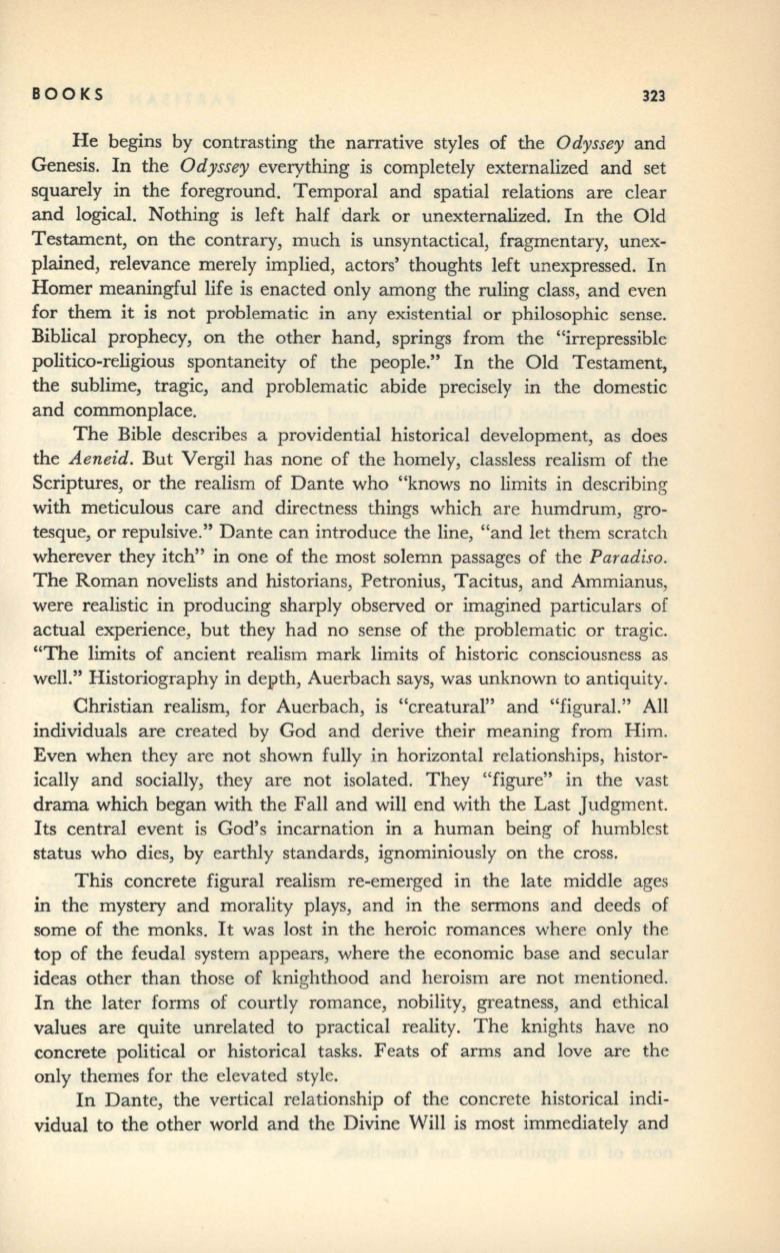
BOO KS
323
He begins by contrasting the narrative styles of the
Odyssey
and
Genesis. In the
Odyssey
everything is completely externalized and set
squarely in the foreground. Temporal and spatial relations are clear
and logical. Nothing is left half dark or unexternalized. In the Old
Testament, on the contrary, much is unsyntactical, fragmentary, unex–
plained, relevance merely implied, actors' thoughts left unexpressed. In
Homer meaningful life is enacted only among the ruling class, and even
for them it is not problematic in any existential or philosophic sense.
Biblical prophecy, on the other hand, springs from the "irrepressible
politico-religious spontaneity of the people." In the Old Testament,
the sublime, tragic, and problematic abide precisely in the domestic
and commonplace.
The Bible describes a providential historical development, as does
the
A eneid.
But Vergil has none of the homely, classless realism of the
Scriptures, or the realism of Dante who "knows no limits in describing
with meticulous care and directness things which are humdrum, gro–
tesque, or repulsive." Dante can introduce the line, "and let them scratch
wherever they itch" in one of the most solemn passages of the
Paradiso.
The Roman novelists and historians, Petronius, Tacitus, and Ammianus,
were realistic in producing sharply observed or imagined particulars of
actual experience, but they had no sense of the problematic or tragic.
"The limits of ancient realism mark limits of historic consciousness as
well." Historiography in depth, Auerbach says, was unknown to antiquity.
Christian realism, for Auerbach, is "creatural" and "figural." All
individuals are created by God and derive their meaning from Him.
Even when they are not shown fully in horizontal relationships, histor–
ically and socially, they are not isolated. They "figure" in the vast
drama which began with the Fall and will end with the Last Judgment.
Its central event is God's incarnation in a human being of humblest
status who dies, by earthly standards, ignominiously on the cross.
This concrete figural realism re-emerged in the late middle ages
in the mystery and morality plays, and in the sermons and deeds of
some of the monks. It was lost in the heroic romances where only the
top of the feudal system appears, where the economic base and secular
ideas other than those of knighthood and heroism are not mentioned.
In the later forms of courtly romance, nobility, greatness, and ethical
values are quite unrelated to practical reality. The knights have no
concrete political or historical tasks. Feats of arms and love are the
only themes for the elevated style.
In Dante, the vertical relationship of the concrete historical indi–
vidual to the other world and the Divine Will is most immediately and


